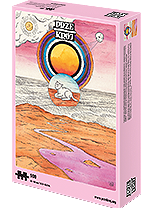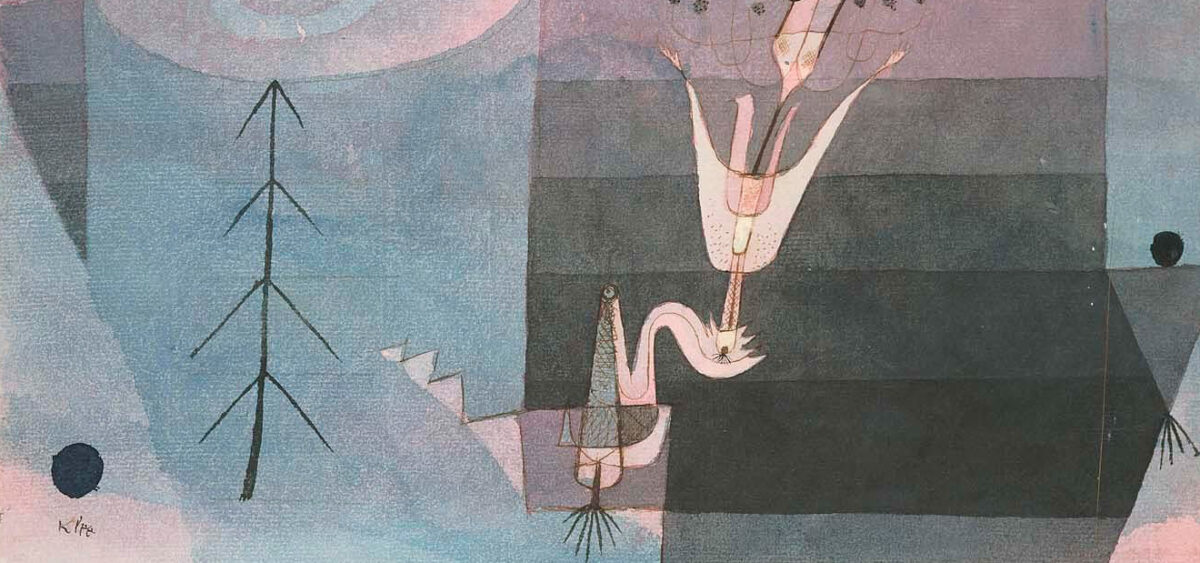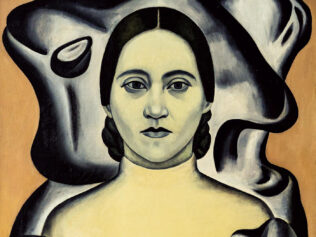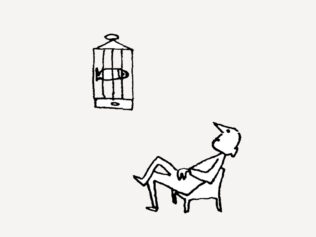
Let’s imagine a world without imagination. Or that what remained at the bottom of Pandora’s box wasn’t Hope, but Imagination. The second version is easier to visualize because without imagination there can’t be any hope, either. Nor can there be plans for the future, readiness to rebel, inspiration to break old habits, the ability to bite off only as much as we can chew, and the desire to continue living, despite everything.
Let’s imagine… Imagine that! It’s unimaginable! It’s impossible to imagine! It’s beyond human imagination! These phrases have permanently entered our language, yet we never stop to think about what they mean. After all, they describe the crossing of boundaries between what is and what might be; between what surrounds us and what is in our minds; between reality and fantasy. The connections between the Polish word for imagination (wyobraźnia) and the word for freedom (wolność) aren’t entirely coincidental. Freedom without imagination is difficult to imagine. Similarly, there’s a close connection between the English words ‘imagination’ and ‘image’ – because it’s impossible to imagine anything in isolation from an image.
Imagination is the enemy of routine and the dread of dictators, pedants, bores, clergymen and conservatives. It’s the force that drives the world. Without it there would be no rebellions, social revolutions, scientific discoveries, distant voyages, romances breaking class divisions, games, entertainment, or enjoyment of life. There would be no art or literature. There would be no romantic comedies or horror movies. Visionaries would vanish from the world. There would be very little left.
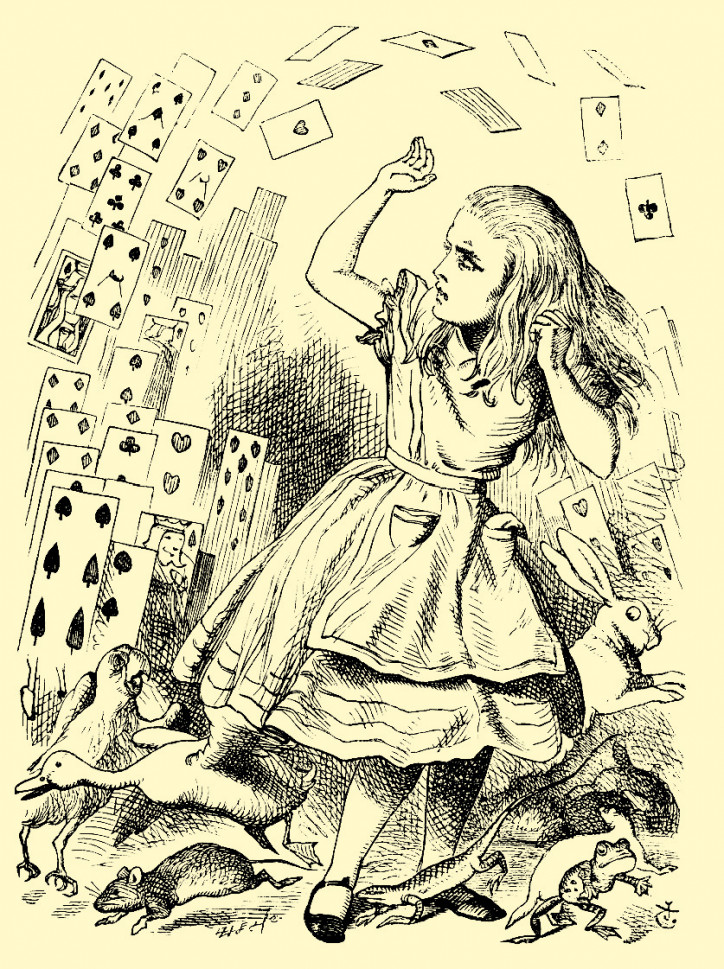
When she’s in Wonderland, Alice becomes so accustomed to unusual events that she finds ‘normal’ life boring and silly. She learns that adventures which undermine the familiar rules governing our world enhance the imagination. So she imagines, for example, herself vanishing like a burnt-out candle. Then she imagines what a flame looks like after a candle has been blown out. Lewis Carroll doesn’t describe exactly what Alice sees, thus stimulating our imaginations as well.
The Surrealists were honorary citizens of the Land of Imagination. Lewis Carroll was worshipped by Louis Aragon. In Carroll’s nonsense, Aragon perceived a revolt against Victorian morality; he pointed out parallels with Lautréamont’s The Songs of Maldoror and Rimbaud’s A Season in Hell. André Breton included “The Lobster Quadrille” in his Anthology of Black Humour. Alice in Wonderland has continued to inspire the surrealist imagination, for example in Franciszka Themerson’s illustrations published in 1946, Roland Topor’s book Alice in the Land of Letters (1968), and Jan Švankmajer’s film Alice (1988).
*
Imagination is the friend of understatement and ambiguity. It subverts an identity that had previously seemed clearly defined, and allows us to believe we can change. Alice likes to pretend that she’s two people at once (she even tries to pull her own ears for cheating in a game of croquet).
Thanks to imagination, no one is unambiguous. Imagination is always surreal because it’s never concerned with describing the world realistically. It’s an omnipotent ally of social change. In May 1968, Parisian students appealed – via the Situationists – to the surrealist imagination. Their poetic phrases such as ‘Power to the imagination!’, ‘A beach under the cobblestones!’, ‘Be realistic: ask for the impossible!’, ‘One works better when asleep, so let’s create Dream Committees!’ had a stronger appeal than the theses of philosophers and politicians. Using surrealist slogans, the students launched a revolt that liberalized society.
*
Breton erected a monument to the imagination already in his first Manifesto of Surrealism (1924): “To reduce the imagination to a state of slavery […] is to betray all sense of absolute justice within ourselves.” He saw a manifestation of awakened imagination in mental illnesses, and he explained patients’ apparent indifference to suffering by the strength given to them by imagination. “And, indeed,” he wrote, “hallucinations, illusions, etc., are not a source of trifling pleasure.” He recalled how the writer Philippe Soupault, exercising his imagination, used to ring random doorbells to ask if Philippe Soupault lived there. An affirmative answer probably wouldn’t have surprised him…
In Surrealism and Painting, published in 1920, Breton extended the term ‘surrealist’ – previously used primarily in reference to literature – to the visual arts. He argued in his book that poetry and painting affect the subconscious in similar ways. “The artistic imagination remains in an intimate relationship with various cosmic phenomena,” he claimed, giving evidence of the fascination with esotericism that characterized him at the time.
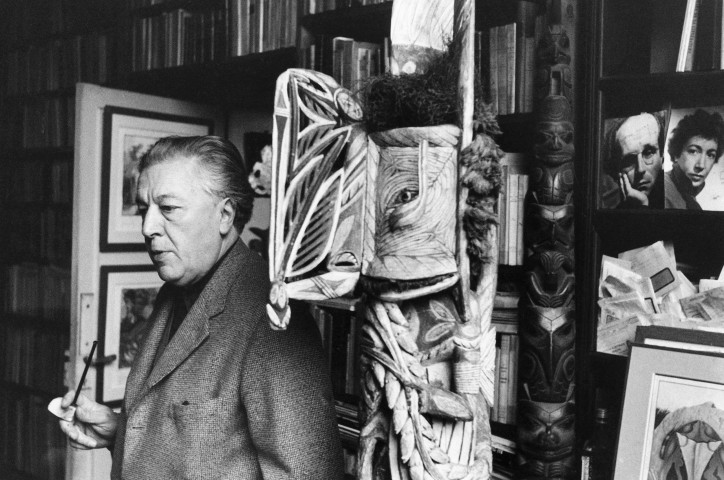
Throughout the 1920s, the Surrealists never ceased exercising their imaginations. Despite numerous rifts within the group, nothing was able to dispel their conviction that imagination was the greatest treasure. In keeping with Rimbaud’s rallying cry to escape from ordinary life by wandering aimlessly around Paris, they put into practice the idea of ‘automatic wandering’, which encouraged the transformation of routine into a realm of fantasy. They liked to be photographed with their eyes closed, gazing deeply into themselves and into the depths of imagination. Films, literature, works by ‘crazy artists’ and visits to fortune tellers helped stimulate their imaginations.
Here are some of the Surrealists’ sources of inspiration, which may also prove useful in firing up our imaginations nowadays. First, The Love Letters of a Portuguese Nun – a collection of spicy letters addressed to a French aristocrat that was published anonymously in French translation in 1669 and is alleged to have been written by Mariana Alcoforado, a Portuguese Immaculata. Second, the character of the Bleeding Nun from Matthew Gregory Lewis’s novel The Monk (1796) – a penitent soul clad in a bloodstained habit who abducted and tormented young men who were unaware that she was a spectre. Third, Fantômas, a novel by Pierre Souvestre and Marcel Allain, who believed that reading it would stimulate readers’ imaginations. They encouraged them to read the entire volume at one go, as quickly as possible.
And then there was Louis Feuillade’s adaptation of Fantômas – a series of half-hour films made in 1913 and 1914 that glorified freedom, ambiguity, a poetic mood, frenzied love, and the power of the imagination. The adventures of the black-clad Demon of Evil took place in a contemporary city that the director in no way tried to alter. In Paris, which was so familiar and recognizable to the audience, there was a trained boa constrictor lurking at every corner or a bandit jumping out of a laundry basket. The Genius of Crime, endowed with a great imagination, crept along rooftops and evaded pursuit, escaped from prisons, poured petrol into fire pumps, blew up residential buildings, derailed trains, sank ships, substituted an unwitting actor at his own execution, and never left any fingerprints because he wore gloves made from the skin of a corpse. The introduction of modern props into the improbable plot, and the mixing of fantasy with everyday life, as well as relics of the Belle Époque with the realities of the 20th century, immersed the novel and the film into a contemporary iconosphere. After leaving the cinema, the familiar streets seemed to swell with horror. Discussing Feuillade’s film adaptation of Fantômas in Mercure de France in 1914, Apollinaire used the term ‘surrealism’ for the first time.
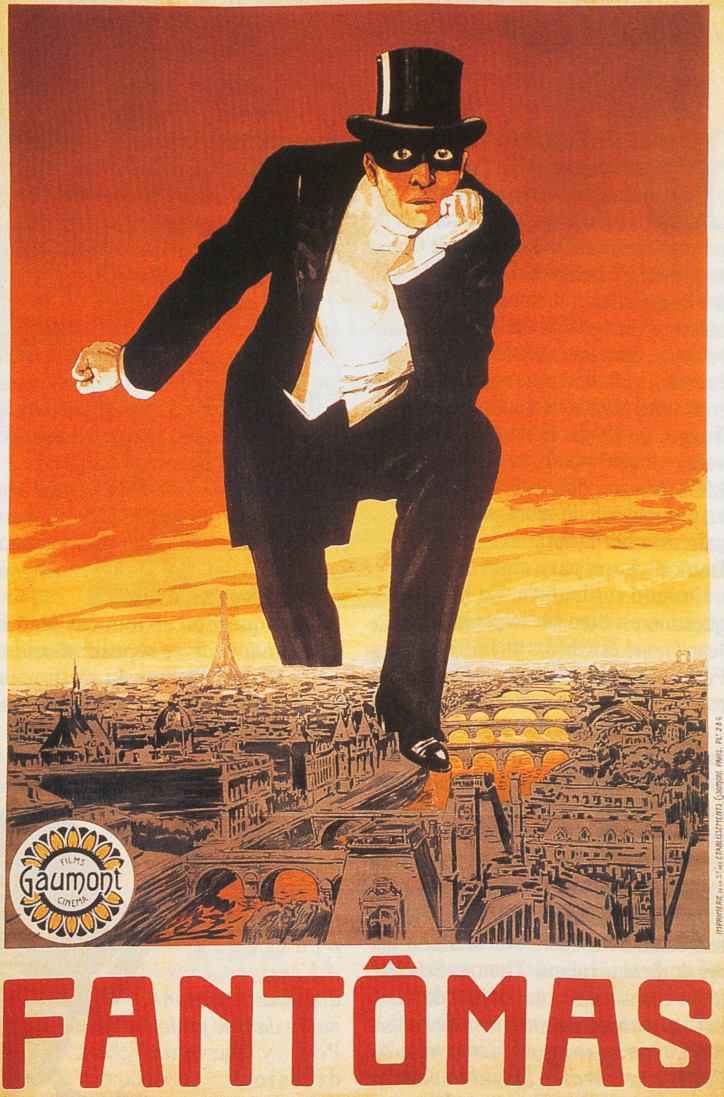
At a time when France was pursuing a pro-natalist agenda and viewed women as mothers of future soldiers, Feuillade made the film Les Vampires (1915–1916), in which he brought to life Fantômas’s feminist sister, Irma Vep (whose name is an anagram of the word ‘vampire’), played by the actress Musidora. Wearing a skin-tight black leotard and dramatic makeup à la Theda Bara, this leader of a gang of criminals captured the imagination and aroused the senses.
A building that was greatly admired by the Surrealists was the ‘ideal palace’ in Hauterives, near Lyon, built at the end of the 19th century by a crazy postman named Ferdinand Cheval, who devoted 33 years to its construction. It’s 26-metres long and 11-metres high and consists of stones, shells, pieces of glass and tiles that he collected while delivering letters, all bound together with wires and cement. Modelled on a building that its creator – a traveller of the imagination – saw in a dream, it was a Mecca for artists.
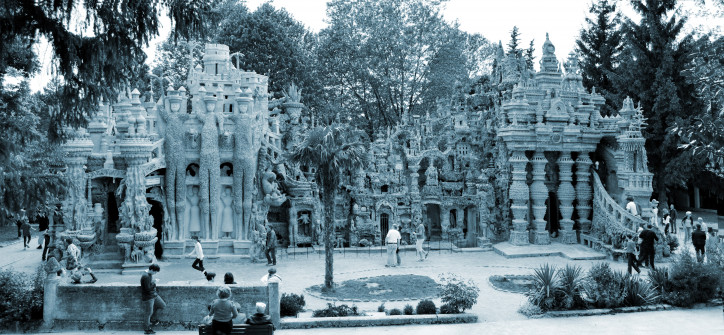
In addition to books, films and ‘hypnotic’ architecture, visits to psychics stimulated the Surrealist imagination. In Breton’s “A Letter to Seers”, written in 1925, he compared these ‘guardians of the Secret’ to poets. He considered the fulfilment of prophecies to be of secondary importance, believing that the mission of fortune tellers was to open the gates of the imagination, beyond which facts blend with potential events. Breton often visited Madame Sacco, the clairvoyant mentioned in his novel Nadja, in whom Max Ernst also placed his confidence.
*
With their minds thus stimulated, the Surrealists went into action. For two months – from September to November 1922 – during what came to be known as the ‘period of dreams’, considered by some to be the very first year of Surrealism, hypnotic séances were held in the Bretons’ flat. Simone Breton compared them to the darkest passages in Lautréamont’s The Songs of Maldoror: “Extraordinary things are happening here. […] Spiritism is not the right word for it, although some of André’s friends have discovered incredible psychic abilities in themselves. The apartment at 42 Fontaine Street has become the site of fantastical séances, during which we’re immersed in a dramatic, suspenseful atmosphere. It’s dark. We sit silently around a table with our hands outstretched in front of us. […] We’re simultaneously in the present, past and future. After each session we feel so bewildered and exhausted that we promise ourselves never to do it again, but then the next day we have only one desire: to plunge once again into that atmosphere of impending doom while joining hands, everyone filled with the same apprehension” (Simone Breton, Lettres à Denise Lévy (1919–1929)).
The Surrealists adopted the atmosphere of the Spiritualist séances so popular at the end of the 19th century: dim lighting, theatrical gestures, held breath, eroticism hovering in the air, hands joined over a round table, and knees under the table. Instead of summoning ghosts, however, they were more concerned with exercising automatism, tapping into the subconscious, and – above all – developing the imagination. They were forerunners of modern psychology, except that the aim wasn’t to cure the ‘patient’ but to immerse him as deeply as possible in the fever of imagination. Due to his leadership skills, Breton became the main hypnotist. However, he stopped the experiments out of fear of losing control over the sleepers after some participants disappeared from the parlour during a séance and attempted to hang themselves on the coat racks in the front hall of the hostess’s villa. Breton later recalled the séances as a dangerous adventure.
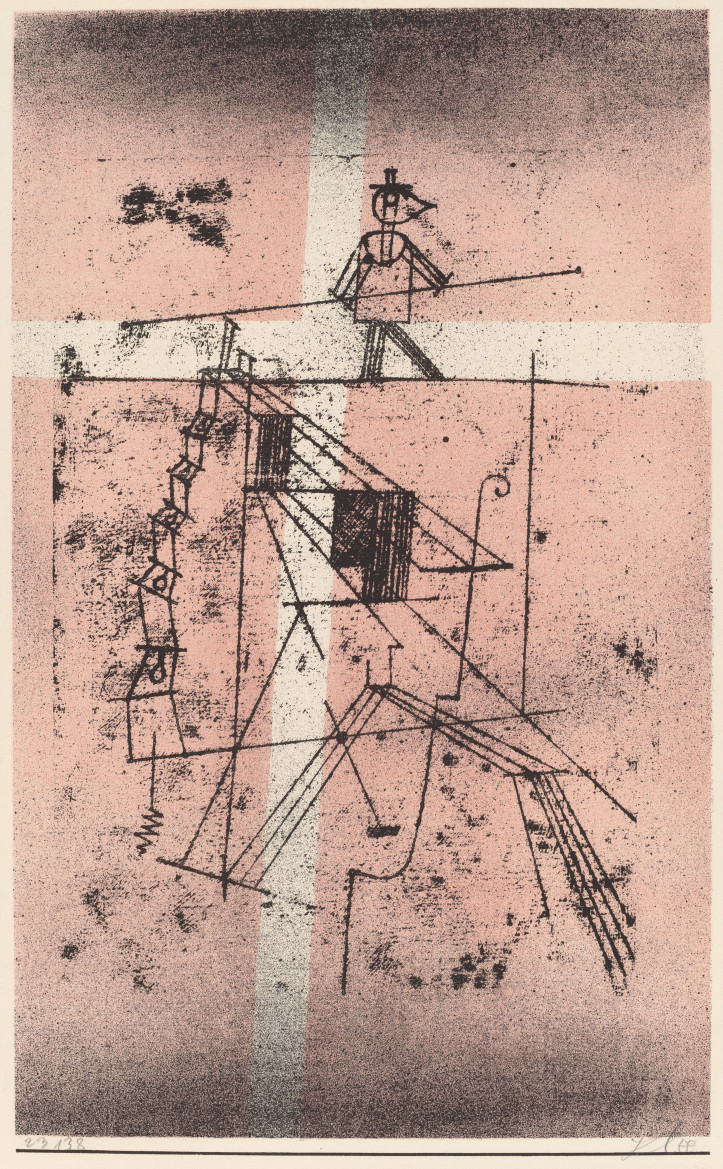
The poet and medium Robert Desnos, arrested during World War II for his participation in the resistance movement, escaped into imagination in his final moments by reading the palms of his fellow Auschwitz prisoners being taken to the gas chamber and foretelling long and happy lives for them. According to a fellow prisoner, this irrational behaviour caused the guards to abandon their plan and take the condemned men back to the barracks. Desnos’s imagination saved their lives.
*
Luis Buñuel, undoubtedly the most outstanding and visionary film director among the Surrealists, was a keen observer of wildlife. He was convinced that animals have imaginations that are much richer than those of Homo sapiens. I’m inclined to agree with this theory after observing sleeping dogs.
Buñuel believed that life is ruled by chance and mystery, between which slips imagination that embodies absolute freedom. He warned against attempts to control imagination. He believed that thoughts shouldn’t be subjected to any limitations, and was disturbed by the Christian concept of sin committed in one’s mind.
He often said that imagination is our greatest treasure and that it should be trained and developed just like memory. He did this constantly in his own mind. In his films, he strove to stimulate the viewer’s imagination, as in the understated scene of crippled Tristana stripping off her clothes on a balcony in front of a lustful boy standing in the garden (Tristana, 1970). In an interview conducted by José de la Colina and Tomás Pérez Turrent (published in their book Objects of Desire: Conversations with Luis Buñuel, New York, 1992) there’s the following passage:
“Tomás Pérez Turrent: One of the most erotic scenes in the film is the one in which Tristana exhibits herself to the deaf boy. It’s a close-up, so we don’t see her display her nudity, but the scene has a genuine erotic splendour.
Luis Buñuel: I’m very discreet and besides I care above all about stimulating the viewer’s imagination. To show her breasts would have weakened the scene, no?”
Similarly, in Belle de Jour (1967; a film about prostitution in which there is also no nudity), the contents of a black box brought to a brothel by a fat Korean man – which aren’t shown to the viewers – cause the women to stare in awe. The viewers’ imaginations run wild.
The list of objects that evoke sudden and unexpected reactions in the protagonists of Buñuel’s films, objects so non-obvious that they remain riddles for the viewer and food for the imagination, is long: the toe of a garden statue in The Golden Age (1930), women’s slippers in Diary of a Chambermaid (1964), a burlap sack and a handkerchief in That Obscure Object of Desire (1977), and many others. As Tristana puts it: “Two columns are never the same. If you look at them closely, you’ll always notice some differences. I always choose between things: two grapes, two bread rolls, two snowflakes…, because there’s always something that makes me like one of them more.” Thanks to these objects, the viewer is no longer merely a passive recipient, but also participates in weaving a story created by the imagination.
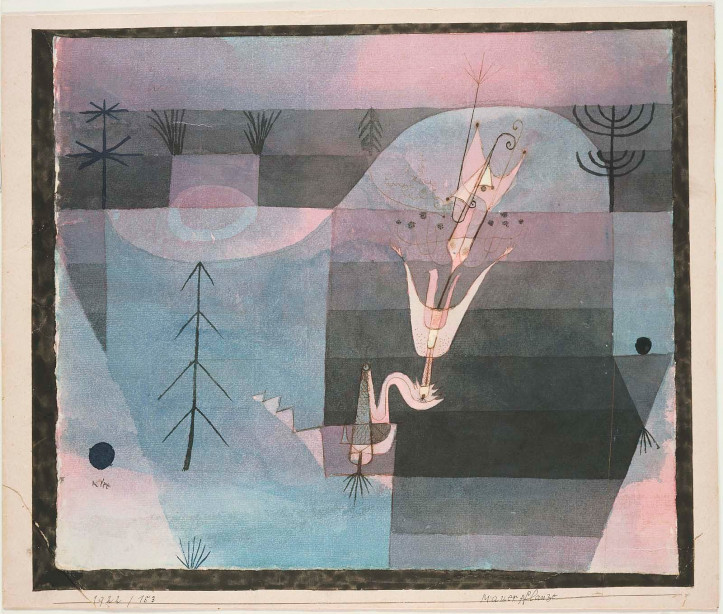
Surreal objects, often acquired at flea markets, produce a similar effect. They combine the prosaic with the oneiric and are ambiguous, expressing the inexpressible and proving that surreality can be found in reality. In Communicating Vessels and Mad Love, Breton compared the liberating effect of dreams on the imagination to an unexpected encounter with a found object. But this is a subject for another story…
Towards the end of his life, Buñuel claimed that his imagination was always on high alert and would accompany him until his death. No longer able to consume his favourite drink, a dry martini – the recipe for which he left for posterity in his memoir My Last Breath and in the film The Discreet Charm of the Bourgeoisie (1972) – he thought about the pleasure it evoked as he watched guests enjoying the cocktail.
While writing their screenplays, Buñuel and Jean-Claude Carrière would lock themselves away for weeks at a time in a hotel far from any distractions. Every day they would stop working for half an hour and go to their own rooms, where they would each invent a story or episode connected to the film or not. Afterwards, they would meet in a bar (provided there was no music playing) and tell each other what they had come up with. In Le réveil de Buñuel (Buñuel’s Awakening; 2011), Carrière states: “It was all about exercising that strange muscle we call the imagination; we didn’t want to let it shrink or become dormant. ‘Our mind is always ready for a nap,’ Luis used to say. ‘One must stay alert.’” In his book, written almost 30 years after Buñuel’s death, Carrière describes visiting Buñuel in the Montparnasse cemetery (although his ashes were scattered in the Desierto de los leones in Mexico) and meticulously writing down the conversations they had in the depths of the tomb. He describes the conversations as follows: “Imagination, the queen of life. Fading away after death. Crazy, real, supernatural. Our gift, our curse. [Buñuel] used to say, and would certainly repeat now, that this secret ability gushing from the hidden abysses, beneath which there is nothing at all – this boundless power capable of turning the world upside down and which presses itself urgently into our heads, causes us anxiety, then immediately vanishes – is innocent. Or rather, it is incapable of committing a crime, sin, or any ‘evil deed’.”
Carrière adds a sentence that proves the prophetic power of imagination: “We sometimes happened to imagine a major catastrophe, the most terrible one in the history of the world: for example […], that a deadly virus destroys at least half of humanity.”
*
Roland Topor was a wellspring of reflections on the subject of the imagination. He even founded the Society of Imaginary Geography and planned to publish a great atlas of the Imaginary World in an infinite number of volumes. This project – proving that Topor wasn’t interested in real places on a map – was unfortunately never realized. He divided literature into that which drew on fantasy and that which faithfully described reality. He preferred the former. When asked about his inspiration, he most often mentioned imagination. One drawing inspired another; each subject stirred the imagination. Playing around with how many versions of the same situation he could imagine (for example, a guy sliding down a banister) was so absorbing for him that he sometimes stumbled upon new scenes even in his sleep. He claimed, however, that imagination doesn’t exist in a pure form because it’s created by memories blended together.
“The sugar-coated cruelty of the realm of the imagination only somewhat sweetens the bitter cruelty of reality,” he wrote in Pense-bêtes [Rules of Thumb]. This quote explains his artistic philosophy: no product of the imagination can transcend the cruelty of reality. Nature was not his ally; his creative mind provided much more interesting inspiration. In an interview with Eddy Devolder, he confessed: “For myself, I’m like a sea or a mountain […]. My drawings are a reaction to the flood of images rushing at us from all directions. Impossible images that can’t be found in nature interest me much more.”
In an interview with me, he further elaborated on his idea that “identification with nature is a failure of imagination”:
“Agnieszka Taborska: You’re strongly opposed to didactic literature.
Roland Topor: Of course, although readers expect it. They’re afraid that reading a novel might be a waste of time. They would rather learn about the history of a place, or how a bank operates, or how a particular social group makes a living. They consider literature which is purely based on imagination to be useless, because they don’t see reality reflected in it. They demand information, and they don’t consider as information stories that are born from a writer’s mind. But I value books that have no pedagogical function” (Literatura na Świecie 1997, no. 8/9).
Topor preferred Belgium to France and the surrealism there to the French version of surrealism, which on the one hand was too politicized, and on the other had been effectively cheapened by Salvador Dalí. “I often have the impression, as many Belgians do, that Belgium is a ship of fools. […] Two-thirds of Belgian reality consists of the imaginative world” (Frantz Vaillant, Roland Topor, ou le rire étranglé [Roland Topor: Stifled Laughter], 2009).
He treated imagination as the supreme value on which a free life and creativity depend. In the same interview he told me: “As people grow older, they become covered with a shell and their imagination becomes poorer. Of course, the passage of time does not bring about only negative effects; sometimes it makes art more profound. But it’s hard to plan anything because you don’t know what you’ll be like in a few years. That’s why I try to do so many things at once. Writers especially need to hurry. Painters feel more independent with age; old writers, however, write with increasing difficulty. If a painter can no longer draw a straight line, he draws a curve – but words can’t be altered so easily.”
Topor connected the act of telling lies with imagination. He considered the first lie to be the most important moment in the development of a child, giving a taste of freedom and making the child realize that through the power of words one can change reality by replacing it with the world of imagination.
*
For the motto of my book Świat zwariował. Poradnik surrealistyczny. Jak przeżyć [The World Has Gone Mad: A Surrealist Handbook on How to Survive] (2021), I used a quote from Buñuel: “Reality devoid of imagination is merely a poor substitute for reality.” He made this statement in an interview with Tomás Pérez Turrent, and it referred to a scene in his 1956 film Death in the Garden: lost in a jungle, a group of people find a plane wreck, and in it they see champagne bottles, jewellery and evening attire. “I was attracted to the idea of turning the jungle into a parlour. It’s like opening a window into the imagination, right? One character looks at a postcard from Paris and feels as if he were on a street or boulevard full of neon lights and passing cars. Reality devoid of imagination is merely a poor substitute for reality. You know, after all, that I’m not a neorealist.”
Świat zwariował. Poradnik surrealistyczny. Jak przeżyć contains 56 tips to help you transcend reality. Tip number 33 – ‘How to Use Your Imagination’ – states: “With the conviction that it’s worth surrendering yourself wholly to it, both in sleep and in waking life. Remember that no one has the right to limit your imagination.”
And with this recommendation I bid you farewell, while wishing for all of us that our imagination will survive difficult times unscathed. But I can’t guarantee that it will, because – as has already been said – it’s the enemy of routine and the dread of dictators, pedants, bores, clergymen and conservatives…
Translated from the Polish by Scotia Gilroy

